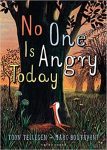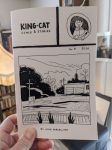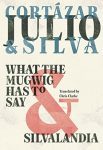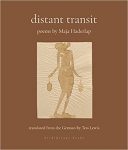Tom Bowden has selected ten recent books each under 100 pages for review. Some of these books are short stories or zines, available direct from publisher links. Other titles are available at Book Beat or can be ordered from our affiliate pages at Bookshop.org. Mr. Bowden reviews small press books in his column i arrogantly recommend… published in our monthly newsletter.
 No One Is Angry Today
No One Is Angry Today
Toon Tellegen and Marc Boutavant (David Colmer, trans.)
Gecko Press
A set of stories for 8–11-year-olds whose topic is anger and its variations. The stories are frequently funny and almost always puzzling: Why do the characters (a set of animals and insects) act as they do?
In the first story, “The Firebelly Toad & the Hedgehog,” Firebelly Toad goes on a rampage, abusing every friend he goes out of his way to harm. Curiously enough, although the friends are all outraged by the harms inflicted, they seem equally puzzled by Firebelly’s behavior and talk over, as a community, how to understand and manage the harm. In “The Ant,” the eponymous hero wakes up on a gloomy, rainy day, only to be confronted by the spiny specter of Anger lying in wait. The Ant wants nothing to do with anger but finds the more he tries to fight it off, the angrier he becomes. Their battle stops short when Squirrel knocks at the door inviting Ant out for a walk, while Anger slinks away.
In each story, the characters grapple with conflicts within themselves and directed toward others. No one has an “aha” moment. The solutions are emotionally complex, nuanced, varied, and understood only by the individuals—as in life, little instruction about managing our inner lives is ever explicitly spelled out.
Toon Tellegen has been writing for children since the early ‘80s. Marc Boutavant’s illustrations match the energy of the stories: multi-(dark)hued, spiky, and emotion drenched. I Wish, also by Tellegen (and illustrated by Ingrid Godon), is another excellent exploration of tween emotions.
 Horses Drawn with Blue Chalk
Horses Drawn with Blue Chalk
Rocío Agreda Piérola (Jessica Sequira, trans.)
Ugly Duckling Presse
The prose poem that opens Horses Drawn with Blue Chalk, “Sunlight Will Win,” reads like an invocation to the book’s themes. Openly unreliable, the narrator states about the story he is going to tell, “It was dictated to me, or maybe I’m inventing it right now. . . This isn’t completely true.” “I’m in a hospital. . . I have no inner world.” The narrator’s uncertainty regarding what is truthful, we are assured, is not an evasion or due his inability to articulate his thoughts: “It’s as if my language were a material that molded itself perfectly to my thought.” And yet, “I’m not happy about this way of describing. It’s too imprecise.” “I’m an illiterate man” who is “going to learn to write” to “cure myself of you” by “spit[ting] out a book.”
If this is the book, the spit consists of time, solitude, and silence, and the ambiguous malleability of language. Just as a word’s semantic content changes over time, what happens over time as a cultural practice can change too:
within that silence I build my house I sharpen my pencils
and brush my hair
within that house I bless the light and its caress
within that house I laugh like a madwoman
I pick out my dress my century and my country
at the exact level of my error
within that house I undo and outdo myself
I convince myself it’s been the only way century after century
until now
(from “Autumn Stabs Us from Its Pages”)
It’s that “until now” the poem builds toward, transforming the words into a poem. Every verb represents a self-chosen and self-building act—the uncertainty and incoherence of the book’s beginning have been channeled through and transformed by the discipline of gaining literacies of the self, culture, and communication into “a form of speaking that isn’t collapse, / a serpent’s language to save me / when I plummet.”
Jessica Sequira’s translation is, as usual, lucid, with rhythms that match English’s natural patterns.
 Letters from Mom
Letters from Mom
Julio Cortázar (Magdalena Edwards, trans.)
Sublunary Editions
Published for the first time in English, and in a translation that captures the narrator’s tics without sounding like something translated, Letters from Mom is a short story by Cortázar written around the same time as his story, “Blow Up,” from which movies have been made.
The plot is simple: Luis and Laura have a third among them, of whom neither speaks but alone dwell on: Nico, Luis’s dead brother. Luis and Laura, who have moved from Brazil to France, keep in regular contact with Luis’s mother by mail. A mistake in a letter she sends upsets the equilibrium of silence among the family members about Nico, Luis, and Laura. The implications of that mistake propel the story’s remainder.
 King-Cat Comix & Stories, No. 81
King-Cat Comix & Stories, No. 81
John Porcellino
Spit and a Half
Maybe people would start writing letters again if rather than recount their lives chronologically they sent their friends their own Top Forty list from the past three months: a beautiful sunset that wowed, what a favorite groundhog is up to, a song that made them tear up. John Porcellino has been doing something like that and more since 1989, writing and producing his autobiographical zine, King-Cat, 28 pages a time, on a roughly quarterly basis.
Much of each issue consists of cartoons—fusing a light, airy line to big spaces—describing a pedestrian moment in a day; remembering why he’s always enjoyed Saturdays; illustrating his groundhog and bird sightings, including their habitat and habits; listing his dreams; and describing other ephemera that make up a life. Porcellino, now 52, has been trying to carve out a sane existence that allows him to enjoy nature, his trade (cartooning), and the love and friendship those in his life offer him—which probably make the tough times easier to endure. Many of the one-page strips are like illustrated haiku, striking and beautiful. Some of his readers, whose letters he reprints, often relate their own encounters with feral critters.
He notes in his dream journal, “Dreamt I was in a motel room with Mike Pence, talking about morphine. I was eating a plain, dry baked potato; he way lying back in the bed with an icepack on his head.” And that, I think pretty much sums up the tone of the King-Cat series: a little bit morphine, some baked potato, and an icepack.
 A Cypresse Grove
A Cypresse Grove
William Drummond of Hawthornden
Sublunary Editions
A meditation upon and apology for death, written in 1623, Drummond of Hawthornden considers the pains and anxieties that accompany it, sifts through evidence and experience, derives analogies and metaphors, and proposes reasons being grateful for the transition from life to death. Life’s value and purpose, whether to rage against the dying of or go toward the light and why it matters—these and more issues have concerned every generation as it comes within spitting distance of death. And whether one takes a spiritual or secular stance toward the issue, Drummond is a persuasive and pleasing debater who never relies on sentimentality to make his points.
 What the Mugwig Has to Say & Silvalandia
What the Mugwig Has to Say & Silvalandia
Julio Cortázar and Julio Silva (Chris Clarke, trans.)
Sublunary Editions
A playful tone reminiscent of Ionesco’s book for children Stories 1 2 3 4 permeates this slim volume, a tone childlike rather than “for children.” Originally published separately in limited artists’ editions, the two illustrated collections of stories by Cortázar and illustrated by Silva are nonsensical baubles from a topsy-turvy world. The illustrations to What the Mugwig Has to Say were inspired by the stories Cortázar handed Silva, and the stories Silvalandia by the illustrations Silva handed Cortázar. And the illustrations are as outlandish as the stories, populated by creatures formed of scratchy geometric shapes with lips, eyes, and feathers attached, in blotchy pastels.
Let the following passage from “Unusual Choices” stand for the rest:
He can’t make up his mind.
He can’t make up his mind in the least.
He was offered his choice of a banana, a treatise by Gabriel Marcel, three pairs of nylon socks, a percolator under warranty, a blonde with pliable virtues, or early retirement, and still he cannot make up his mind.
His reticence has given rise to insomnia in a number of civil servants, a vicar, and the cops of the district.
As he cannot make up his mind, some have begun to wonder whether he shouldn’t be subject to a residence ban.
This was made clear to him, just like that, in a gesture of kindness.
He said, “In that case, I’ll take the banana.”
 He Spoke of Love: Selected Poems from the Satsai
He Spoke of Love: Selected Poems from the Satsai
Biharilal (Rupert Snell trans.)
Murty Classical Library of India / Harvard University Press
Biharilal was an early 17th-century Hindi poet, making him roughly contemporary with John Milton, Anne Bradstreet, Margaret Cavendish, Basho, Moliere, and Juana Inés de la Cruz. He was famous for a collection of 700 couplets, called Satsai, based on the erotic lives of the gods Krishna and Radha, depictions of which were already popular when he wrote. In He Spoke of Love, Rupert Snell has translated and transformed 400 of those couplets, setting them on three lines rather than two (for reasons he explains in the introduction).
Biharilal’s erotic poems work within the Hindi tradition of addressing love, trysts, yearnings, and so forth through the actions of Krishna and Radha. Here are two of them, numbers 80 and 88):
He’s on his back, and she’s astride him.
Her waist bells sing a fanfare
and her anklets hold their tongue. (#80)
At the door she turned, glanced artfully, and smiled;
she’d come for curd to turn the milk,
but as she left she turned my heart. (#88)
Snell warns readers that, because Biharilal worked with well-known tropes, he could keep the poems brief via allusions his audience would already know and understand. For contemporary non-Hindi readers in English, the couplets’ allusive lines and images may risk becoming opaquely abstract, for which ample footnotes are available. My own reading, however, found the poems rife with images, metaphors, and analogies, enough so I could arrive at a sense of their spirit (though my sense may make historically inaccurate assumptions). Thus, for me, the poems can be read and enjoyed as much as any other well-wrought works, without the endeavor turning into a stern academic duty.
He Spoke of Love does not tell as story. Each couplet stands alone, describing a moment, a feeling, an emotion stirred and longing stoked. Thus, the book is good for dipping into via chance for readers who want a quick jolt of images pleasing to meditate upon.
The Murty Classical Library of India, published by Harvard University Press through a grant by a computer engineering entrepreneur, is a series of translations aiming to cover works from India’s many cultures and languages. Thus, it is an extension of the Clay Sanskrit Library. Beginning in 2015, it has published dozens of classics in a uniform hardcover edition, and many also available in paperback. Production values, from translation to design, are all impeccable. Worth being an obsessive collector of.
 [title]
[title]
[name of author]
[independent “prestige” press (aka / Sublunary Editions)
Presented as a detailed, chapter-by-chapter outline of post-modern novel, [name of author]’s [title] is a tip of the hat to Lawrence Sterne’s Tristan Shandy (with the works of many other authors alluded to) and a parody of literary conventions, genres, and tropes. As with some of the finest avant-garde literature, [title] has no plot—Fictional Character is usually just waking from sleep or a bad fall as the Narrator wonders on Fictional Character’s behalf why he (“pronominal evidence suggests male”) should get up and what he should do. Clearly, [name of author] has been collecting examples of avant-garde clichés for a long time. I don’t know the background to the [title]’s composition, but I can imagine its origins as a list of conventions and clichés which were then transformed—solely for the author’s own amusement—into a book. It’s kind of an in-joke for a certain set of readers and well worth the read. I suspect that [title] will fly—or sputter, more likely—under the radar, but it really deserves a wider audience. Apart from a good bit of intellectual fun, it also can serve as a type of study in rhetorical structures and choices building materials.
 distant transit
distant transit
Maja Haderlap (Tess Lewis, trans.)
Archipelago Books
i’ve become a measly weed,
base, disgraceful and very common.
that’s what’s ordinary about my nastiness.
(From “rageweed”)
Maja Haderlap imbues her terse lines with concrete images to tell stories of the heights and depths of love (“house of love”), entangled history and language (“almost homeward,” “distant transit”), mother / daughter estrangement (“the invisible girl”), and the everyday.
Reminiscent of the narrator of Beowulf opening his “word-horde” (per Seamus Heaney), for Haderlap (per Tess Lewis) “language opens / rotted doors, thrusts the dusty boards / from their brackets, reveals the buried stone. / it flies at my face like a flock of startled / swallows, confronts me as the smell of mold, / drops from the jagged armor and / hulls of kids’ stuff like silt shed from all that was.” (“home”) (Internal rhymes and alliterations are components of many poems in this collection, nicely captured by Lewis’s translation.)
Coming from a Slovenian-speaking minority living along the border shared by Austria and Slovenia, potential and active conflict (personal and political) perpetually hover over all part of a life. In “summer skirmish,” the erotic is compared to its opposite, which is always intrusively here, unignorable. I could only think of Ukraine today as I read these lines:
i have barely put my arm around you
on this lovely placid morning
when the fleet of bees begins its maneuvers.
behind our backs, a base camp tirelessly
spits out warriors. in the sky
motors howl, in a dog fight,
in a nuptial flight. . .
Then after the historic devastation, the return:
a village searches for the way back from
absence. backs to the wind,
houses cling to each other, the aged
heart of the village drifts
in all directions, walls
spotted as if from fever, as if smeared
with charcoal pencil. . .
. . . here it stood, before it was left behind
in the updraft of progress with the ghosts
that follow it everywhere.
(From “goce return”)
Compelling, beautifully rendered, and of immediate relevance.
 Chasing Homer
Chasing Homer
László Krasznahorkai (John Bakti, trans.), Max Neuman (illustrations), and Miklós Szilveszter (soundtrack)
New Directions
László Krasznahorkai again teams up with artist Max Neuman (see their AnimalInside), with percussionist and jazz drummer Miklós Szilveszter providing a soundtrack for each chapter (accessed via a QR code heading each chapter or the URLs provided at the book’s end).
The narrator is a modern-day Homer, whose post-war wanderings owe not to happenstance delays to his trip home caused by vengeful gods but to a paranoid belief that he was being pursued by an unseen harmful “them,” and to escape from requires a happenstance-seeming set of evasions. He speaks to us in rushed, run-on sentences that pile up cause upon cause for his actions and evasions:
. . . all I’ve ever had was merely a constant awareness of their presence, which has been enough to avoid being nabbed by them, always enough, and anyway there really isn’t any need for me to see them, I have no desire to see them, scared that the sight would make me so afraid that I won’t have enough strength left, because seeing them would paralyze my will to escape. . .
Once he began running from this unseen greater power, he
always opt[ed] for the wrong speed, making bad choices, but unpredictable ones, sometimes going too fast, sometimes too slow, and at times—my favorite methods, if I may say such a thing—randomly alternating the fast and slow, to the point where such haphazard movements might almost call attention to me, but, no, there are limits, I can’t become conspicuous, that would take away whatever crabbed enjoyment I can derive from all this. . .
His successful evasions ultimately lead him to Odysseus’s Cave along the Adriatic Coast (it really exists), an utterly secluded cave accessible neither from shore nor land but by an underwater tunnel that emerges into a grove inside the island, nestled among tall cliffs. Once there, “they” will never find him. How long will his paranoid journey last? What will it take to end it?
Propelling him along this journey is jazz drummer Miklós Szilveszter’s (mostly) percussive soundtrack, which ranges in sound from tribal-ritual to ominous and determined. Max Neuman’s illustrations are raw and scratchy, lightly tinted with shaky outlines of faces in profile, straight-on, with backs turned, and so forth, with an energy mirroring the narrator’s mental agitation.
